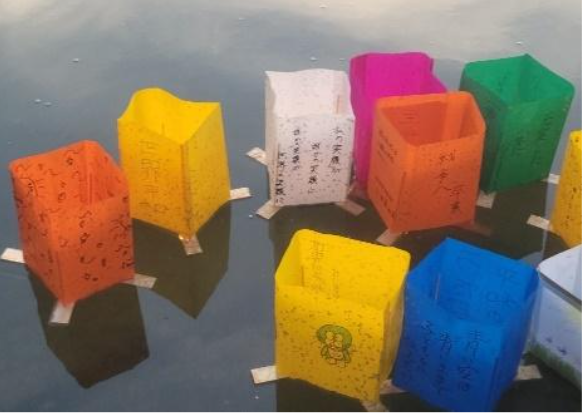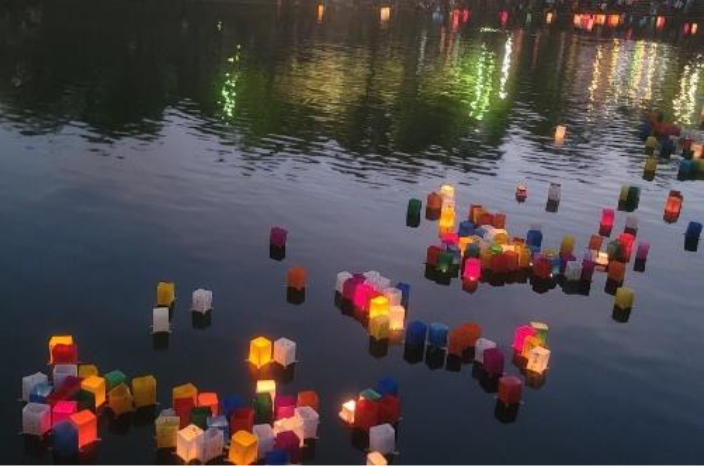Remembering Those Lost in The Bombing
This article was originally featured in the October 2024 issue of Connect.
Veronica Nielsen (Hiroshima)
Imagine hundreds of bright, colorful paper lanterns floating peacefully down the Motoyasu River before the Hiroshima Atomic Bomb Dome. When twilight breaks, the lanterns come to life as candles illuminate them and their messages calling for world peace. This rare spectacle is the heart of the Hiroshima Lantern Ceremony.
On the evening of August 6th every year, the city of Hiroshima hosts its lantern ceremony to honor the lives lost during the atomic bombing in 1945. According to the city’s official website, estimates suggest that around 140,000 people died because of this horrific event . With about 350,000 people present in the city on the day of the bombing, many died or suffered devastating injuries alongside Japanese citizens, including exchange students and immigrants from other countries in Asia, prisoners of war, and others.

Since then, Hiroshima has held the lantern ceremony each year, attracting city residents, Japanese citizens from other prefectures, and visitors from all over the globe. From 6:00 p.m. until around 9:00 p.m., locals, students and tourists created and placed their lanterns in the river, each bearing a call for peace. This year, visitors could view countless lanterns gently drifting along the river, their collective glow reflecting the city’s powerful message of hope.
One by one, two by two, lanterns in bright colors drifted alongside one another, making it easy to appreciate their hand-drawn illustrations, like the dove of peace. Others had various symbols of Hiroshima like the Carps baseball team mascots. Some more artistically ambitious even displayed detailed landscapes, including countryside and cityscapes. Written along their sides were short, concise messages that drove their ideas home with four kanji characters that mean “world peace”.

Watching the lanterns slowly drift along the Motoyasu River is a far from somber experience. On the contrary, it seemed to provide multiple spectators peace of mind. Many people watched silently as more and more lanterns were placed in the river for others to gaze at. Which direction the lanterns flowed from and where they headed didn’t matter. Simply watching them move down the river calmly provided a relaxing mood and assurance in knowing they continued downstream, as nothing else could capture a strong sense of peace like this. Instead of creating a gloomy atmosphere for an event surrounding the bombing, organizers took the lantern ceremony in a more positive direction by opening room for attendees to share a broader range of ideas promoting a world free from atomic warfare.
Gently bobbing up and down in the water, candles flickering steadily, the sight only grew more beautiful as the sun set. A few lanterns suffered an unfortunate fate of burning up in the water, but nothing about the event and the atmosphere put the audience on edge. As attendees and event organizers staggered placing lanterns into the water, it drew attention to the clusters of lanterns and their messages written by people from Hiroshima and all over the world.
While the in-person event leaves a far stronger impression on viewers, an online lantern ceremony took place when the in-person event got canceled for 2020 and 2021 due to the COVID-19 pandemic. People from any country could submit messages online to appear on lanterns that flowed down a digital river to preserve facets of the in-person ceremony. The city’s willingness to consider and implement ideas with current technology helped keep the Hiroshima Lantern Ceremony as relevant as before the pandemic began. As the coronavirus has subsided on a larger scale, the in-person event shows promising signs of continuing every year when possible.
The Hiroshima Lantern Ceremony fulfills its purpose by visually demonstrating the wishes of its attendees to remember the atomic bombing, as they also hope for a future without similar tragedies. Participants releasing their lanterns into the river also meaningfully encouraged more people to understand the severity of the bombing. Less than a five-minute walk from the Hiroshima Bus Center and about a 20-minute train ride from Hiroshima Station, the Atomic Bomb Dome is easy to reach. If you happen to visit Hiroshima around the anniversary of the atomic bombing, be sure to check out this incredible ceremony and create a lantern representing your message and ideal vision for a brighter future.

Veronica Nielsen is a Coordinator for International Relations (CIR) in Hiroshima Prefecture. She has traveled to all four of Japan’s main islands, and hopes to visit all 47 prefectures one day. Her hobbies include drawing, reading, writing, traveling, and attending concerts.




